
Great Lakes Center Newsletter: Issue 23
November 14, 2023
This issue features our fieldwork Lake Ontario and the other Great Lakes, the invasive crayfish management at the Park School, and a GLES student spotlight. We also celebrate ten years of the WNY PRISM Crew Assistance Program, the President's Award given to Dr. Karatayev, the graduation of one of our GLES students, welcoming our new researcher, and announcing the retirement of one of our researchers.
Benthic Palooza in Lake Ontario
by Olesia Makhutova (Kormilets) and Susan Daniel

In September, another Cooperative Science and Monitoring Initiative (CSMI) survey took place in Lake Ontario. A team of scientists from the Great Lakes Center boarded the research vessel Lake Guardian in the Port of Rochester. The R/V Lake Guardian is owned and operated by the U.S. EPA and is used for all major surveys on the Great Lakes. The vessel is outfitted with advanced scientific equipment like the rosette water sampler and well-equipped laboratories that collect some of the best data in the region. Prior to departure and the official start of the survey, GLC scientists Alexander Karatayev, Lyubov Burlakova, Olesia Makhutova (Kormilets), and Lillian Denecke were given a safety briefing, at the end of which they were required to don red immersion suits and looked like astronauts. The immersion suits are very difficult to put on and move in, but greatly increase the chance of survival at sea. Thankfully, these suits never had to come in handy while sailing aboard R/V Lake Guardian!
Lasting only a week, the entire survey was the shortest CSMI survey ever completed by the GLC scientists. During the cruise, samples were taken from 71 locations by an international team of scientists. The R/V Lake Guardian runs non-stop, 24-7, and can be very exhausting for those onboard; luckily, meals are prepared by a cook! While some samples were processed directly on the ship, most of the samples were transported back to Buffalo for further analysis. The primary study of this year was monitoring the state of the benthic fauna, or organisms that live in the sediment of the lake; specifically, how quagga mussels (Dreissena rostriformis bugensis) have changed the environment over the past 5 years. In addition to traditional methods of sampling, a relatively new method of video recording of the sediment surface was used in Lake Ontario. This nearly real time approach successfully revealed that there may be a decrease in the abundance of quagga mussels, especially at depths of less than 50 meters. However, this result will be verified with traditional methods.

including Lyubov and Olesia.
Other research questions were addressed during this CSMI survey. GLC Research Scientist, Olesia Makhutova (Kormilets) initiated a study using fatty acid analysis to describe the diet of quagga mussels living at different depths. Fatty acid analysis can reflect the average trophic level of organisms in the food web and provide clues as to what an organism is eating on a regular basis. Samples of quagga mussels were taken from different depth zones and will be analyzed at the Buffalo State University laboratories. A separate team of scientists from National Oceanic and Atmospheric Administration, Paul Glyshaw and Rachel Orzechoswki, studied morphological changes in quagga mussels along depth and food gradients. Interestingly, quagga mussels are morphologically different at different depths: shallow-water quagga mussels are colored, large, and more voluminous with a thick shell, while deep-water quagga mussels are white, small, and flat with a thinner shell. Another question explored during the CSMI survey by Robin Richardson-Coy, a graduate student of Yvonne Vadeboncoeur at Wright State University, was related to food quality and trophic interactions. Robin collected algae from the surfaces of quagga mussel shells and from various substrates to determine the taxonomic composition and their nutritional quality for consumers. Soon they will be able to figure out which algae are a more valuable food for the lake’s consumers.
Lastly, and the most challenging, were sediment core samples collected by Canadian scientists Maria Dittrich, Khoren Avetisyan, and Zach Diloreto. Sediment cores were used to measure oxygen and other chemicals in different layers of the sediment. These samples can be very difficult to collect from hard substrate like rocks, gravel, and sand. However, results from this project will help us to better understand how quagga mussels change the sediment-water interface, and thus the ecosystem at a chemical level for other creatures.
During the entire week, professional photographer Yola Monakhov Stockton (formerly Buffalo State faculty, currently at University of Hawaii) “captured” our work on the ship. Yola’s “samples” were not only moments that could be captured in photographs, but also in movements and sounds of our work. She tried to capture all the most interesting moments of the cruise and, it seems to me, she succeeded. Perhaps soon we will have the opportunity to watch a film about the survey and see everything that happens there from a completely different perspective.
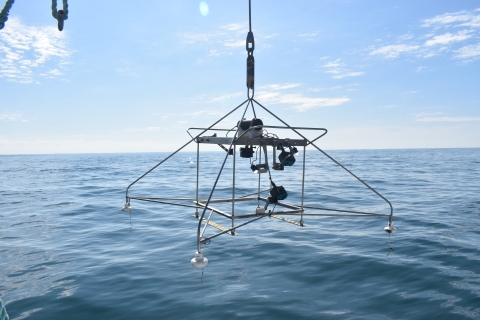

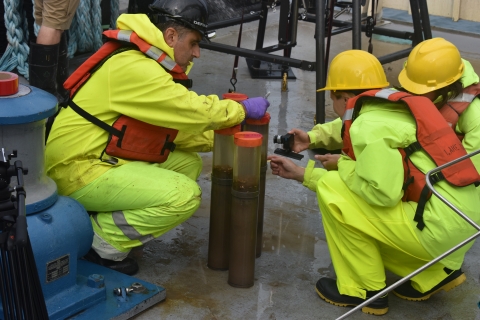

sounds of the survey.
Another year collected
by Susan Daniel
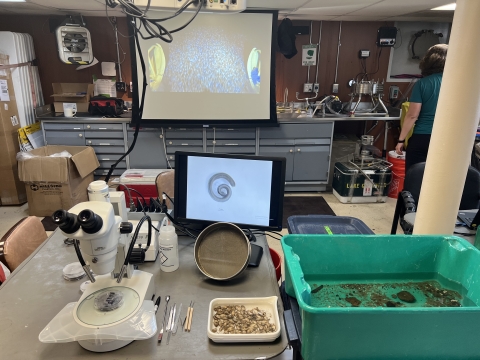
equipment, pictures, and videos.
Researchers from the Great Lakes Center returned to sampling as a part of the Great Lakes National Program Office (GLNPO) Biology Monitoring Program. The Great Lakes Center has been participating in this annual survey since 2013, so this year was our 10-year anniversary! This was the first survey in two years that was completed without unexpected engine trouble, sampling all five Great Lakes in the order of Lakes Michigan, Huron, Erie, Ontario and lastly Superior. GLC scientists Susan Daniel and Angela Tulumello set sail out of Milwaukee, Wisconsin on August 1, 2023. Everything went by the book with great weather, wonderful fellow scientists, and a great crew.
Part way through the survey, the ship hosted tours in Detroit, Michigan during the Brownfields 2023 conference, which focuses on environmental revitalization and economic redevelopment. Susan and Angela were asked to provide information on our work and talk with stakeholders about the importance of monitoring the Great Lakes. During the first tour, Susan had the opportunity to speak with Debbie Dingell, the U.S. representative for Michigan’s 6th congressional district. During the second tour, Rashida Tlaib, the U.S. representative for Michigan’s 12th district, was present.
The second half of the survey left the Port of Rochester on August 18th and headed back towards Lake Superior. Lillian Denecke joined Susan, while Angela went back to the labs with samples to process. Lake Superior is the largest lake by surface area and can be so picturesque. One morning towards the end of the month-long survey, we were able to see the sun rise over Isle Royale. Susan visited the Isle for the first time in June while on a backpacking trip, and to see it from the water at a monitoring station created a memory to last a lifetime. Isle Royale is the least-visited national park in the U.S. but is the most revisited. Unfortunately, no moose or wolves were seen during Susan’s backpacking trip or while “on-station”- maybe next year!
In total, GLC scientists were able to collect samples from 56 stations throughout all five Great Lakes. Due to truly astounding teamwork, we are already nearly finished sorting the samples collected during this survey! Although sorting out our targeted organisms is the first step, it often takes the most time. We expect to be finished with all the samples by the end of October. The team enjoyed beautiful sunsets, sunrises, and prepared meals, but most of all they enjoyed being out on the water.
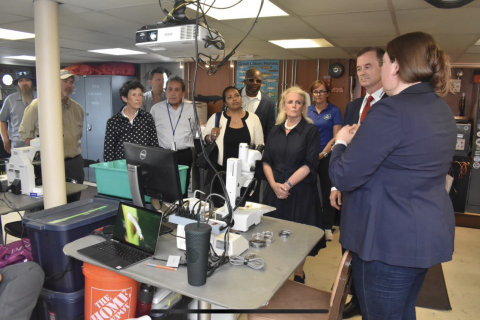
(fourth from right).
Invasive crayfish management finds first native species!
by Emily Klimczak, GLES M.A. graduate student

crayfish at the Park School.
Invasive species are a major threat to many ecosystems around the world, including in our own backyards. One such case is the occurrence of the red swamp crayfish (Procambarus clarkii) at the Park School in Amherst, NY. This species was first collected at the Park School by a student in 2020 and since then researchers have been working hard to manage the population size and potential spread of this non-native crayfish. Emily Klimczak, a graduate student, along with her advisor Dr. Chris Pennuto, are currently working on ways to manage this invasive crayfish at the Park School.
Emily, with the help from undergraduate assistant Nick Hahn, has been trapping red swamp crayfish over the summer and will continue her efforts into the fall. This past summer Emily has caught over 800 crayfish! Since its initial finding, nearly 1,200 red swap crayfish have been removed from the pond. While multiple trapping efforts have occurred since 2020, this year saw those trapping efforts nearly tripled over previous seasons. There are traps spread out over the pond, the stream leading to the pond, and the wetland behind the pond. Over the summer, the traps were set 5 days a week. As a comparison, last summer the team caught around 300 crayfish with fewer traps set and over a shorter duration of time. Trapping activities do seem to be having a desired impact of reducing the population size. Summer 2023 resulted in 1.00 crayfish captured per trap night whereas summer 2022 had 1.17 animals collected per trap night.
The increased trapping effort has resulted in an unexpected positive outcome in the Park School ecosystem – the finding of native species! While only a few native crayfish have been found so far, this is a win for researchers as these are the first native species to be seen in the pond since the first red swamp crayfish was spotted in 2020. To date, two native species have been collected at the site. These species include the white river crayfish (Procambarus acutus) and the calico crayfish (Faxonius immunis). Since hundreds of red swamp crayfish were removed from the pond, this could open some room for native species to work their way back into the ecosystem. With intense trapping still happening, there is hope that more native crayfish will start showing up at the Park School.
GLES student spotlight: Mike Kalinka
by Dr. Chris Pennuto

The Great Lakes Environmental Science graduate program just turned 10 years old. In that time, we have had 43 graduate students in the program in either the thesis or internship tracks. This column is an opportunity to highlight the accomplishments of one of those students, past or present.
Mike Kalinka is a current graduate student in his final semester of work in the GLES internship track. He joined the GLES program in spring 2022 after completing his undergraduate degree in Earth Sciences at Buffalo State in 2014. Mike also had a 20-year career with the Erie County sheriff’s office, before making the leap to a different career path where he has retooled himself into a capable GIS technician, completing several courses using geographic information systems (GIS) such as remote sensing, watershed analysis, and environmental planning applications in GIS with faculty in the Geography & Planning Department (now the Department of Geosciences). He parlayed his coursework into an internship with the Erie County Planning Department in spring 2023, where he assisted the county in mapping the occurrence of an invasive insect, hemlock wooly adelgid (Adelges tsugae). That internship experience provided Mike his first exposure to regional planning and indirect outcomes of a changing climate.
In spring 2023, Mike was introduced to planning with an ecosystem perspective in GLES 535 Great Lakes Ecosystem Science, delving into a wide range of topics facing the Great Lakes watershed, including implications from climate change. This coincided with new discussions between GLC faculty and the NY Dept. of
Environmental Conservation (NY DEC) to build more avenues for collaboration. Mike was able to again leverage his academic work in the GLES program and was awarded a NY DEC internship in Climate Resiliency within the Region 9 office, to quantify Lake Erie coastal preparedness for climate change-related scenarios like heightened wave action, rising water levels, and their relationship with nearshore development, all in a GIS environment. To kick things off, Mike will be attending a meeting this month with county and regional management personnel to begin the shoreline resiliency initiative.
In reflecting on his path through the GLES program, Mike says, “Our program is top notch, and I feel it definitely prepared me for a future in environmental work. Honestly, it’s great to work with faculty that share a passion for the Great Lakes, and to be motivated by them.” We are confident Mike will represent GLES, and by extension, BSU, in exemplary fashion in this new pursuit.
Field Station Snapshots
by Kit Hastings and Brian Haas
Several ospreys were spotted hanging out in the vicinity of the Field Station and Scajaquada Creek late this summer, including one that perched on the osprey nesting platform at the Field Station. Though their presence was fleeting, hopefully this is a positive sign that the osprey pole, installed as part of habitat enhancements, might be utilized more in future seasons!
The GLOS buoy was retrieved on an October morning. When Mark and Brian arrived, there was a common tern perched on it.


Sampling Hamilton Harbor
by Lyuba Burlakova, Sasha Karatayev, and Brian Haas

On July 18th, we collected video and benthic samples from 14 stations in Hamilton Harbor (Ontario, Canada) to characterize benthic habitats and to test whether visual classification can serve as an indicator of hypoxia. This survey was made possible by our Canadian colleagues from Fisheries and Oceans Canada, scientists Kelly Bowen and Warren Currie. Captain Robert D. Linley expertly operated his newly built amazing 38-foot DFO boat R/V Cisco, equipped with large open aft deck, a small crane and A-frame, trawling winch, and a very convenient sideboard to wash benthic samples.
Hamilton Harbor has been subject to the impacts of intensive industrial and urban development around its shores for many years, and in addition to being a major shipping center, it still supports one of the largest concentrations of heavy industry in Canada. Three wastewater treatments plants and urban runoff from the cities of Hamilton and Burlington discharge into the bay. Sediments in the harbor are contaminated by metals, PCBs, and PAHs, and the bay suffers from periodic hypoxia. The harbor was designated as an Area of Concern, and its Randle Reef area is considered the largest PAH-contaminated sediment site in the Canadian Great Lakes.
This study was done within the applied research project “Study Great Lakes benthoscapes to investigate large scale changes in benthos composition and distribution affected by dreissenids and eutrophication” in our EPA-funded project “Great Lakes Long-term Biological Monitoring.” Communities of benthic macroinvertebrates are among the most useful indicators for biological assessment of environmental and anthropogenic stressors, but both sample processing and species identification often require several years to complete. Mapping benthic landscapes or “benthoscapes” using underwater video can provide valuable and cost-effective assessment of bottom habitats on large spatial scales with minimal habitat disturbance. In 2019, during the CSMI benthic survey in Lake Erie, we successfully used this approach to characterize benthic habitats and confirmed that video analysis can provide a quick and reliable method to detect habitats affected by periodic hypoxia. Last year, in collaboration with Paris Collingsworth (Illinois-Indiana Sea Grant), his M.S. student Justin Meyer, and Cornell University M.S./Ph.D. graduate student Sarah Lawhun, we sampled Saginaw Bay of Lake Huron at stations where oxygen loggers were deployed to detect near-bottom hypoxia. We are very thankful to K. Bowen, R. D. Linley, W. Currie, P. Collingsworth, and J. Meyer for facilitating our surveys.
The samples from the Hamilton Harbor have been already sorted, and taxa identification and video analysis will be done over winter and spring. By testing this method on several locations in the Great Lakes that suffer from periodic hypoxia, we can determine if video analysis can be used as a quick and reliable method to detect hypoxic habitats. Such rapid methods may be important for regional monitoring of over 20 hypoxic zones documented in the Great Lakes where the extent and magnitude of hypoxia currently represent a major knowledge gap.

a successful survey.
Celebrating 10 years of the WNY PRISM Crew Assistance Program!
by Andrea Locke

Des Jardin, Bergen Swamp Preservation Society Membership Chair, on
barberry removal in 2019.
WNY PRISM is celebrating ten years of our Crew Assistance Program – ten years of great partnerships, projects, success and fun, and we’re excited to be celebrating with you!
The WNY PRISM Crew Assistance Program was established in 2014 (along with our office!) with the goal to build relationships with regional partners, to improve the success of management activities, and increase regional capacity for projects through sharing of resources and expertise. We also wanted to be additive, to provide our partners with the assistance needed to help move projects forward that otherwise wouldn’t have been possible – those projects where a few extra hands could make the most difference. But most of all, we wanted to work with our partners. The Crew Assistance Program (CAP) offers valuable opportunities for partners to work alongside WNY PRISM’s experienced staff and trained seasonal crew to learn about invasive species management and gain experience with various data collection protocols, removal tools and methods, and to see firsthand how strategies including adaptive management and integrated pest management are used to achieve long-term success with invasive species management.
During the first couple years of the program (2014-2015), WNY PRISM actively sought partners and jointly developed projects on which to work. We did a lot of invasive species surveys in those days! But the popularity of the program grew quickly and partner requests for assistance soon outpaced our ability to help. In response, ahead of the 2016 season we developed a process for partners to submit proposals that would be prioritized and selected based on established criteria. This allowed us to assess each project for how well it met our program goals and the overall WNY PRISM mission and priorities, and to fairly make difficult decisions on what projects we’d be able to work on.
From 2016-2023, WNY PRISM received 123 project proposals, averaging fifteen per year. The fewest we received was eight, in 2017, and the most was twenty, in 2019. Proposals have been received from thirty-six different partners for projects in all eight of our counties, the most of which being for projects within Erie (51), Chautauqua (24) and Niagara (22) counties. Eighty-nine project proposals involved removal, thirty-two involved surveys and two focused on native plant restoration. WNY PRISM selected and completed 105 projects from 2016-2023. Partners recognized WNY PRISM’s efforts through social media posts, organizational newsletters and press releases in local newspapers.
With 105 amazing projects to choose from it’s hard to pick just a few to highlight, but those that stand out most are the ones that allowed the Crew to work alongside our partners in some of the most unique locations and plant communities that can be found here in western New York. Our staff and partners were able to learn from one another and especially rewarding was to see those efforts be leveraged for, or transitioned to, new projects that may not have otherwise been implemented.
We are so proud of the work that has been accomplished over the last ten years, and we are looking forward to many more great projects in the future. If you’re interested in learning more about the Crew Assistance Program, visit our website where you can find information on past projects and see our selection criteria. We’ll be releasing the request for proposals in early December for 2024, so if you haven’t started thinking of a project, now’s the time!
Originally published in WNY PRISM Fall 2023 Newsletter. Republished with permission.

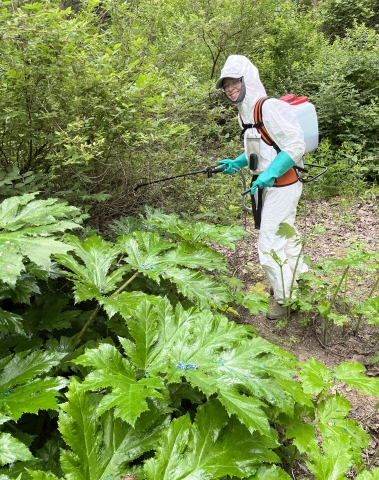
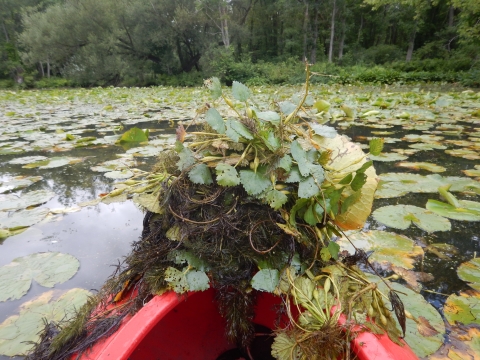

Our new Research Scientist
by Lyubov Burlakova

This fall, the Great Lakes Center appointed Olesia Makhutova (Kormilets) to be our new research scientist. Olesia will work on the U.S. EPA funded project “Great Lakes Long-Term Biological Monitoring Program 2022- 2028.”
Olesia has been engaged in aquatic ecology research for over 20 years. She graduated with honors from the Krasnoyarsk State University in 2003, received Candidate of Sciences degree (Ph.D.) at the Institute of Biology of Inland Waters, and in 2019, she defended the Doctor of Sciences degree (D. Sc.) at Siberian Federal University. Before coming to Great Lakes Center, Olesia was a Professor at Siberian Federal University and a Leading Researcher in the Laboratory of Experimental Hydroecology (Institute of Biophysics, Federal Research Center “Krasnoyarsk Science Center of the Siberian Branch of the Russian Academy of Sciences”). Olesia studied trophic interactions in benthic and planktonic food webs of different aquatic ecosystems in Russia, Belarus, Ukraine, and USA, and is an internationally recognized expert in environmental biochemistry of lipids of algae and aquatic animals. Olesia was the top and best qualified candidate in our job search for Project Coordinator-Research Scientist position (January – March 2023) owing to her extensive number of publications, high h-index (22) and number of citations (1,383) on Web of Science, great experience in grant, report, and paper writing, grant administration (she was a recipient of 20+ grants), and experience in benthic ecology. In the Great Lakes Center, Olesia will be responsible for the Cooperative Science and Monitoring Initiative extensive surveys and data analysis on all Great Lakes. Olesia will also be involved in remote sensing and image processing, as well as in grant management.
We’re glad to have you on board, Olesia!
President's Award for Excellence in Research, Scholarship, and Creativity
by Lyubov Burlakova
Professor Alexander Karatayev, Director of Great Lakes Center, has been honored with President’s Award for Excellence in Research, Scholarship, and Creativity
at the Faculty and Staff Recognition Ceremony on October 12th, 2023. This is the second year in a row that Great Lakes Center faculty has received this award, Dr. Chris Pennuto being the awardee in 2022. The AD Scientific Index lists Sasha as the most productive scientist at Buffalo State, and No. 64 among all aquatic ecology and fisheries scientists in the United States. Sasha is a prolific author and grant recipient, and his contributions to research have made the Great Lakes Center, and Buffalo State, recognized names among the Great Lakes scientific community. Well done, Sasha!

and Staff Recognition Ceremony.
Congratulations, Lara!
by Lyubov Burlakova
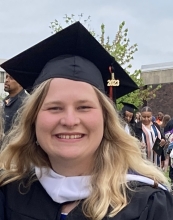
Our student Lara Hargrave graduated this May from Great Lakes Environmental Science M.A. Program. Lara began as a student in the summer of 2020. For her thesis project, Lara was studying the influence of invasive Dreissena mussels on water quality parameters and deep chlorophyll maxima using data previously collected on US EPA water quality surveys throughout the Great Lakes. Lara’s research has shown that several physiochemical parameters, such as water transparency and turbidity, are different between sites with and without Dreissena, and documented changes over time in the deep chlorophyll layers in several
of the Great Lakes, potentially linked to Dreissena. Lara’s research will improve our understanding of how Dreissena shape water chemistry and primary production. With Lara’s background in chemistry from University at Buffalo, it was a steep learning curve to work, to study, and simultaneously to do research in a completely new field of ecology and limnology. She had to master working in R, read a lot of literature, learn scientific writing and language of another field on the way, but she did it with lots of patience and learned quickly. Lara presented her thesis research at multiple Buffalo State student conferences and at the International Association of Great Lakes Research Conference. In spring 2023, she made an excellent and passionate presentation about her educator job in WNY parks at our graduate seminar. Lara will soon start a new job as an environmental educator in Hamlin Beach and Lakeside State Parks. Great job and congratulations, Lara!
Happy Retirement!
by Kit Hastings

GLC researcher and Biology Professor Dr. Alicia Pérez-Fuentetaja retired at the beginning of September. Dr. Pérez-Fuentetaja joined the GLC in 2006 for a position that allowed her to spend a greater amount of time researching than most other faculty.
Dr. Pérez, as students called her, taught several undergraduate and graduate level biology courses like Environmental Biology, Fisheries Biology, Limnology, and Great Lakes Ecology. She was on the planning committee for the creation of the GLES M.A. and M.S. programs and a core member of the GLES faculty. In addition to advising undergraduates, Dr. Pérez was the major professor for over a dozen graduate students at Buffalo State and a committee member for many more, as well as supervising research for several undergraduate students; she also advised some graduate and Ph.D. students at University at Buffalo. She received the Outstanding McNair Mentor of the Year Award in 2015.
Alicia’s work as an aquatic ecologist focused on food web interactions in the Great Lakes ecosystem. This included nutrient studies in Lake Erie (NOLENS and LENONS), the effects of the invasion of exotic species like Hemimysis anomala, changes in zooplankton communities in acidifying lakes in the Canadian Granitic Shield, and the bioaccumulation of botulism type E, persistent organic pollutants like PBDEs, and pharmaceuticals in fish populations and fishing birds. Alicia’s contributions to research led to several well publicized and viral news stories, including the development of fish passage for emerald shiners in the upper Niagara River at Broderick Park and the discovery of antidepressants in the brains of fish in the upper Niagara River. She was also part of the steering committee that successfully obtained a Ramsar designation for the Niagara River Corridor as a Wetland of International Importance in 2019. Her expertise was relied on by groups like the Lake Erie Forage Task Group, the International Joint Commission, national and international press, and local agencies and other stakeholders.
I’ve known Alicia for 20 years, since she was my undergraduate advisor in Environmental Science at SUNY Fredonia in 2003. It was Alicia who told me about the research technician position at Buffalo State that became my job, and we worked together on the Lake Erie Long-term Lower Trophic Level Assessment. I’ve made numerous maps for her over the years, especially for the Emerald Shiner Project. Alicia, thank you for your mentorship and for being my colleague over the years. I and everyone else at the GLC wish you the best on your next chapter!

